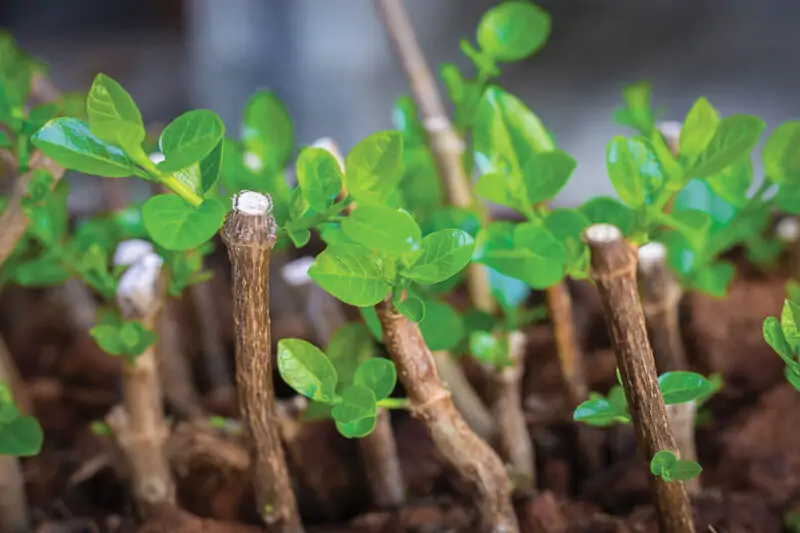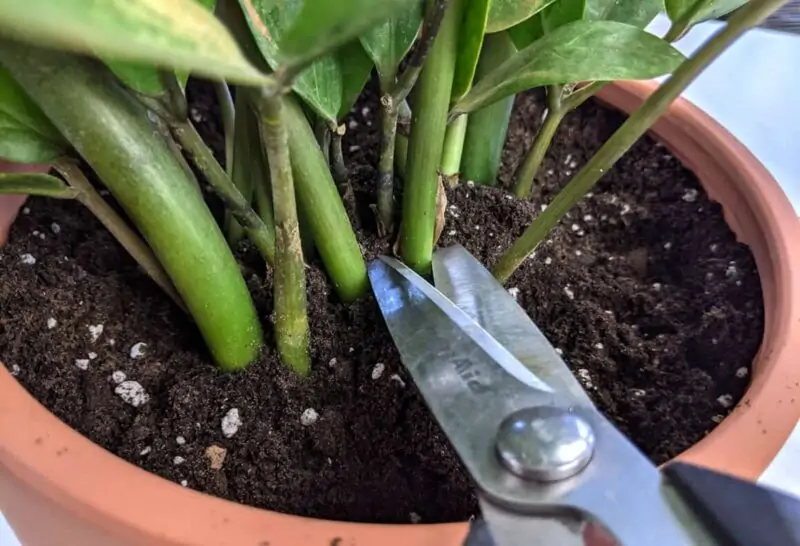Propagate Plants from Cuttings: A Complete Guide to Stem Cuttings Propagation

We’re about to dive headfirst into the incredible world of stem cuttings propagation. If you’re looking to expand your garden without buying more plants, this method is your go-to. It’s pretty simple, highly effective, and just downright fun.
Exploring Various Types of Cuttings
Understanding Stem Cuttings
When we talk about stem cuttings, we’re referring to pieces of stem that are taken from a parent plant, and believe it or not, many of these stem cuttings can grow into new plants. These pieces, which are usually about an inch long, are taken from an existing plant and given the opportunity to develop into a whole new plant. This is a tried-and-true method used to propagate many garden plants, and it’s an incredible way to clone your favorite plants and produce more of the plants you love.
The Different Types of Stem Cuttings: Softwood, Semi-Hardwood, and Hardwood
Stem cuttings come in three varieties: softwood, semi-hardwood, and hardwood. These divisions are based on how old and developed the stem is that is being cut from the parent plant. New, soft growth is harvested for softwood cuttings in the spring or early summer. These are still-evolving plants that haven’t developed into woody ones yet. On the other side, semi-hardwood cuttings are made from partially mature wood that is already growing, often from mid-July to September. Last but not least, hardwood cuttings are made from mature, solid stems during the plant’s dormancy in the late fall or winter.
Leaf Cuttings: An Alternate Way to Propagate
But what if your plant doesn’t have stems? Some plants, such as the famous coleus or certain species of begonias, can grow from leaf cuttings. In these cases, a healthy leaf, or even just a part of it, is cut from the parent plant. The leaf’s base or its veins, depending on the plant species, can spawn roots and eventually an entirely new plant! Talk about plant magic.
Utilizing Root Cuttings for Propagation
Last but not least, there are root cuttings. Just as the name suggests, this type of cutting involves taking a section of a root from a parent plant. Certain types of plants are best propagated this way, and it’s a process that can result in a new plant that’s a genetic clone of the parent plant.
The Art of Taking Stem Cuttings
Selecting the Ideal Section of Stem
So how do you start taking stem cuttings? The first step is to select the right section of stem. Ideally, this should be a healthy part of the plant where new growth is present, but not too young or tender. By taking cuttings from these sections of the plant, you’re giving your new plant the best possible start.
Preparing Your Stem Cutting for Propagation
Keep your cuttings cold and wet after choosing and cutting the proper piece of the stem. Make a clean incision at the cutting’s end and add a rooting hormone to your stem cutting to prepare it. Your cutting will have the highest chance of growing into a new plant as a result of this stimulation of root development.
How to Take Stem Cuttings: Step by Step Guide
Although the process of taking stem cuttings might initially seem complex, it is in reality a straightforward task. Begin by severing the stem, proceed by dipping the freshly cut end into a rooting hormone, and then place it into a pot replete with damp potting mix. Next, cover the pot using a plastic bag in order to retain humidity, and locate it in a well-lit, warm area away from direct sunlight. Monitor your cuttings every few days, ensuring that the potting mix stays damp without becoming waterlogged.
Unpacking the Process to Propagate New Plants
Initial Steps to Propagate Plants from Cuttings
Once you’ve got your cuttings prepared, you’re ready to start the propagation process. First, choose a pot that’s suitable for the size of your cutting and fill it with a well-draining potting mix. Remember to moisten the stem and the potting mix before planting your cutting, which helps to initiate root growth. Then, make a hole in the mix with a pencil or your finger, insert the cutting, and gently firm the mix around the stem.
Planting the Cutting: The Best Way to Propagate
Now, it’s time to plant your cuttings! There’s no one-size-fits-all method to do this, as different plants root best in different conditions. But, in general, stick your cuttings into the hole you made earlier in the moistened potting mix. Try to plant the cuttings at a depth of about one-third their length. This keeps them upright and gives them plenty of room to grow new roots.
The Ideal Pot and Soil Conditions for Propagation
The right pot and soil can make or break your propagation success. The preferred vessels for plant growth are often small pots or cell trays, which should be filled with a potting mix that facilitates good drainage. It is of paramount importance that the chosen pot features drainage holes, as this helps avoid the detrimental effects of excessive water accumulation. For soil, you want something that drains well but can hold enough moisture to keep the cuttings hydrated.
Growing New Plants from Various Types of Stem Cuttings
How to Grow New Plants from Softwood Stem Cuttings
The new development of woody plants is where softwood stem cuttings are obtained. If you want to cultivate new plants from these cuttings, remove them in late spring or early summer when the new growth is still malleable but has started to become slightly harder. This approach is excellent for novices since softwood cuttings root rapidly and readily.
Techniques to Grow Plants from Semi-Hardwood Cuttings
The method of fostering new plants from semi-hardwood cuttings requires selecting portions of the current season’s growth that have begun to solidify. This typically occurs in the waning days of summer or the onset of autumn. Such cuttings embody an optimal blend of mature and young tissues, thereby making them conducive to successful root formation.
Guide to Growing Plants from Hardwood Cuttings
Let’s finally discuss hardwood cuttings. Usually harvested in the winter or late fall when the plant is dormant. Hardwood cuttings frequently require more patience and time to root because to their maturity. But don’t let that deter you! It’s a rewarding process that can result in beautiful new plants.
In-depth Guide to Growing Plants from Cuttings
The Process to Root Cuttings
When you’re rooting cuttings, your aim is to encourage the cutting to form its own new roots. After planting the cuttings in a moist potting mix, they need a good balance of light and humidity to stimulate root growth. It usually takes a few weeks, but with a bit of patience, you’ll start to see new roots grow.
Growing New Plants from Leaf Cuttings
Did you know you can grow new plants from just a leaf? Indeed, leaf cuttings are a fantastic way to propagate many herbaceous plants. The process is a bit different from stem cuttings. After cutting a leaf from the parent plant, lay it flat on your potting mix, burying just the cut end. Keep the soil moist, and soon enough, you’ll see new plants sprouting from the base of the leaf!
Techniques to Root Stem Cuttings
Growing new plants by establishing stem cuttings is a common practice, particularly for woody species. The cutting includes a part of the plant’s stem, which is then encouraged to develop new roots. This process involves placing the stem in water or a special growth medium until roots form.
Unique Methods of Stem Cutting Propagation

How to Root in Water: An Alternative to Traditional Soil Propagation
While most plants root best in soil, some plants, such as Coleus, can be propagated via stem cuttings placed directly in water. Just remember to change the water regularly to keep it fresh, and transfer the cutting to soil once new roots have formed.
How to Propagate Herbaceous Plants
Many herbaceous plants can also be propagated via stem cuttings. Herbs such as mint, oregano, and basil, for example, will readily root from stem cuttings. These herbaceous cuttings are often made when the plant is actively growing, which is in the spring or early summer.
The Process to Grow New Plants from a Section of Stem
You don’t always need the whole stem to grow new plants. Sometimes, a section of stem is enough. Just be certain that this portion has at least one node, which is where the leaf joins the stem. New growth will start to show here.
FAQs about Stem Cutting Propagation
Depending on the plant and the type of cutting, there are several ideal times to take cuttings. For instance, cuttings of softwood are often taken in the spring, those of semi-hardwood in the late summer or early fall, and those of hardwood in the late autumn or winter. Cuttings take root most readily in humid environments with direct, bright light.
These words define the level of ripeness of the stem being cut. Cuttings of softwood come from fresh growth, those of semi-hardwood from partially developed development, and those of hardwood from completely matured growth.
It can take anywhere from a few weeks to several months for a stem cutting to root, depending on the plant and the type of cutting. Generally, softwood cuttings root the fastest, while hardwood cuttings take the longest.
While many plants will root from stem cuttings, not all will. Some plants are best propagated by other means such as seeds or division. Always research your specific plant for the best propagation method.
Conclusion
Stem cuttings propagation is a rewarding way to create new plants, whether you’re a beginner gardener or have a long-standing passion for plants. It allows you to grow many plants from just a few parent plants, and it’s an easy and cost-effective way to expand your garden.